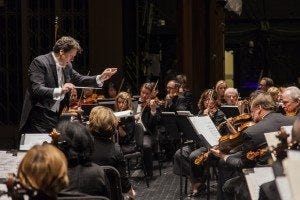Originally written for The Smith Center Blog, Spring, 2015
As I pull together the finishing touches of the 2016–17 season for the Las Vegas Philharmonic, I thought I’d share the process through which I create an evening of entertainment that I hope everyone will enjoy. There is definitely an art to programming a concert, not to mention an entire season. And while the art of programming isn’t often talked about, it can define a conductor and orchestra more than anything else.
It is the music director’s responsibility to choose the music that is to be played every concert. There are a variety of factors that the music director must take into consideration when programming: budget, size of orchestra, marketing concerns, the last time the piece was performed, level of difficulty, etc. And while the music director has the final say as to what comprises each program, I personally always welcome suggestions from members of the orchestra and from the audience.
As I explore the seemingly endless amount of music that is out there, I find that there are composers and specific pieces for which I have a natural affinity. Does that mean I avoid the music that I don’t like as much as, say,Beethoven? Certainly not! But it does mean that, over the course of time, the audience and orchestra will begin to see a music director’s affinities and tastes. Over the course of many seasons, an orchestra’s and conductor’s personalities begin to emerge. One can’t think of the “Philadelphia Sound” without acknowledging Leopold Stokowski and Eugene Ormandy, or the “Cleveland Sound” without acknowledging George Szell, or the “Chicago Sound” without Fritz Reiner and George Solti, and the list goes on.
Where do I start? I begin with a wish list of pieces that I’ve always wanted to do, or that I’ve wanted to conduct again. I add to this list music that people have requested to hear, as well as concertos for solo artists who I would like to work with. I then check to make sure we’re not performing a piece of music that we’ve performed within the last five years. I then start assigning the largest piece, often found within the second-half of a concert, to a specific date, making sure that the season begins with something big and ends with something grand.

It is important that there be a connecting thread between all of the pieces of the program. In other words, if I program aTchaikovsky symphony, it might be nice to have a fellow Russian’s piano concerto during the first half, like Rachmaninoff. Or, knowing that Tchaikovsky’s favorite composer was Mozart, perhaps a Mozart violin concerto would be appropriate. In other words, the thematic content of a program arises from the music, not the other way around.
One of the commitments I have made that defines my programming style is to my fellow composers, the ones that are alive and well and living down the street from you and me. I firmly believe that if this art form is to remain relevant, we must continue to support the music of living composers as best we can. So, with that said, I do program new pieces, but I am very careful to program pieces by composers that I really believe in.
After I’ve added the finishing touches to each program, the next step is matching this to the budget that has been projected for the upcoming season. In order to afford to perform a Mahler symphony, which can require more than a hundred musicians, it might be necessary to have a concert by Mozart and Haydn, whose music requires much smaller forces. Many drafts of a season will be exchanged between the administration and the music director and, hopefully, as is the case with the Las Vegas Philharmonic, this process will help to create an even more persuasive season.
Programming is a skill not taught at a conservatory, yet is an essential ingredient to being a successful music director. I look forward to sharing with you my ideas for 2016–17 very soon. In the meantime, I hope you join us for the remainder of the 2015–16 season.
